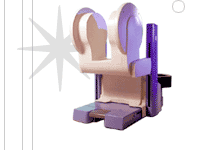|
Magnetic
Resonance -
Technology
Information
Portal |
Welcome to MRI Technology • • |
|
|
 | Info
Sheets |
| | | | | | | | | | | | | | | | | | | | | | | | |
 | Out-
side |
| | | | |
|
| | | | |
Result : Searchterm 'Image Guidance' found in 0 term [ ] and 54 definitions [ ] and 54 definitions [ ] ]
| previous 31 - 35 (of 54) nextResult Pages :  [1 2 3 4 5 6 7 8 9 10 11] [1 2 3 4 5 6 7 8 9 10 11] |  | |  | Searchterm 'Image Guidance' was also found in the following service: | | | | |
|  |  |
| |
|
Quick Overview
DESCRIPTION
Loss of contrast between two adjacent tissues
The Partial Volume Artifact is caused by imaging voxel containing two different tissues and therefore possessing a signal average of both tissues.

Image Guidance
| |  | | | | | | | | |  Further Reading: Further Reading: | Basics:
|
|
| |
|  | |  |  |  |
| |
|
The partial volume effect is the loss of contrast between two adjacent tissues in an image caused by insufficient resolution so that more than one tissue type occupies the same voxel (or pixel). That may induce a partial volume artifact, dependent on the size of the image voxel. If fat and water spins occupy the same voxel, their signals interfere destructively. A small amount of water signal may be eliminated by a larger lipid signal from the same voxel, resulting in a voxel that appears to contain only lipid. The partial volume effect is minimal with thin slice thickness and sufficiently high resolution, so that fat and water or other different structures are unlikely to occupy the same voxel.

Image Guidance
| |  | |
• View the DATABASE results for 'Partial Volume Effect' (2).
| | | | |
|  | |  |  |  |
| |
|
Quick Overview
Please note that there are different common names for this artifact.
REASON
Movement of the imaged object
HELP
Compensation techniques, more averages, anti spasmodic, presaturation
This artifact is caused by movements of the patient or organic processes taking place in the body of the patient.
The artifact appears as bright noise, repeating densities or ghosting in the phase encoding direction.

Image Guidance
| |  | |
• View the DATABASE results for 'Phase Encoded Motion Artifact' (5).
| | | | |
|  |  | Searchterm 'Image Guidance' was also found in the following service: | | | | |
|  |  |
| |
|

From Odin Medical Technologies, Inc.;
the PoleStar™ N-10 is a compact, mobile MRI scanner that mounts to a standard operating room table. The magnets raise into position for imaging, but lower to make surgery easier, and the low magnetic field makes it possible to use many conventional surgical instruments.
When not in use, the PoleStar™ is stored in a nearby closet that allows the room to be used for conventional surgical procedures. The PoleStar™ N-10 is supplied with a fully integrated image guidance system that utilizes intraoperatively acquired images.
The successor, the new PoleStar™ N20 sets a new standard in intraoperative magnetic resonance imaging.
Device Information and Specification CLINICAL APPLICATION Intraoperative | |  | |
• View the DATABASE results for 'PoleStar™' (2).
| | | | |
|  | |  |  |  |
| |
|
Quick Overview
DESCRIPTION
Signal loss, intensity variations

Image Guidance
| |  | | | |
|  | |  |  |
|  | |
|  | | |
|
| |
 | Look
Ups |
| |
|
MR-TIP.com uses cookies! By browsing MR-TIP.com, you agree to our use of cookies. | | | [last update: 2024-02-26 03:41:00] |
|
|